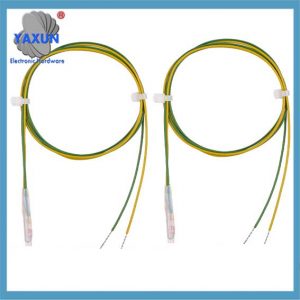As the EV electric vehicle market grows, the EV temperature sensor Cable harness market will also grow with it. The reason is simple: just like vehicles with internal combustion engines, electric vehicles require high-performance and accurate temperature detection and sensor technology to ensure performance and safety.
Electric vehicles EV have always been in the spotlight in the transportation industry. Son yıllarda, automakers have competed to bring electric vehicles and trucks to the masses. It will only become more competitive as consumers are now more environmentally conscious and governments are taking legislative measures to reduce carbon emissions.
The electric vehicle trend that has dominated in recent years is not expected to weaken this year in any way. Aslında, the electric vehicle market is only expected to grow. Dahası, cars and trucks are not the only vehicles expected to switch from fossil fuels to more environmentally friendly energy. Name a vehicle type, and there is likely an electric alternative already.
New technology brings more new technology.
Electric vehicle trends to watch in 2023
The biggest electric vehicle trend we can expect this year is electric vehicles themselves. By this, we mean that the electric vehicle market is expected to continue its ongoing trend of gaining more market share. Kısacası, the adoption of electric vehicles is not expected to slow down at all.
Recall: İçinde 2018, only 2.1 million electric vehicles were sold worldwide. This year, sales are expected to nearly triple to 6 million units, and that number is likely to increase even more. Aslında, this year may be the first year that electric and gasoline-powered vehicles may sell for nearly the same price.
We can expect improvements in the range and performance of electric vehicles. Electric vehicles are no longer limited to basic small commuter cars. We will start to see more high-performance electric vehicles with higher range and power capabilities, making them viable options for luxury car buyers as well.
On the charging side, we can expect an electric vehicle trend towards better charging infrastructure and technology. More electric vehicle charging stations will be added around the world, which will be important in encouraging the adoption of electric vehicles.
Nihayet, government incentives will continue to drive consumer interest in electric vehicles this year. With the growing awareness of global warming and increasingly stringent emission standards. Governments from around the world – most notably, Çin, India, and the European Union, have implemented various financial incentives to encourage consumers to buy electric vehicles instead of gasoline-powered vehicles.
EV Industry Trends: Growth Beyond Sedans and Pickups
While electric cars and electric trucks are front and center of the “electrification revolution,” they are just two components of an overall sea change in transportation and EV trends.
Virtually every vehicle type will be electrified. Many financial reports and EV industry trends indicate that this transition is well underway. Other vehicles you’ll see more of besides cars and pickups include:
Buses: From buses that transport school children to those that support urban commuting, all-electric bus fleets are on the horizon. Federal lawmakers are eyeing billions of dollars to fund the transition of transportation systems away from fossil fuels.
Semis: One of the largest vehicles on the road is one of the most impactful ways to reduce emissions. The electric semi market is expected to more than double by 2026.
ATVs and Utility Vehicles: The smallest of these vehicles will be electrified by 2030. The ATV and utility vehicle market is expected to grow from $468 million in 2020 ile $4.3 billion.
Aircraft: The skies are about to get a lot greener with the shift to electric aircraft. Many major airlines are planning to follow the automotive industry and eliminate fossil fuel use from their fleets.
Marine: The electric marine market is already worth $5 billion and is expected to reach $10 billion by 2026.
New Energy Vehicle Trends and Temperature Sensor Technology: Growing in Sync!
As the global fleet shifts from fossil fuels to electricity, the role of sensor technology—especially in battery management—will become critical.
Just like the refueling system of an internal combustion engine, the battery system of an electric vehicle requires constant monitoring to ensure optimal performance and safety. EV temperature sensors for batteries are more than just an updated version of a fuel gauge. They are sophisticated tools for measuring key performance elements such as:
Thermal Management
Energy Management
Battery Health
Humidity Control
1. Thermal Management
One of the most hostile environments for electric vehicle batteries is overheating. If left unchecked, thermal runaway can occur, during which the battery degrades and releases flammable gases. Without intervention, a battery thermal event can even trigger a chain reaction throughout the battery pack, with more cells experiencing thermal runaway until the pack is damaged beyond recovery.
Ek olarak, piller, motorlar, and inverters all have a temperature window where performance is high, but outside of that window, performance degrades. For batteries, the optimal range is about 15C to 35C. At cooler temperatures, the internal dynamics of the battery drive lower charge and discharge rates, reducing available pack power. Whereas at higher temperatures, the battery degrades rapidly. This requires the system to be controlled by a heat exchanger that can either extract heat from the battery or add heat as needed, all of which requires accurate temperature sensor feedback.
When it comes to EV battery thermal management systems, there is no shortage of places to integrate sensor technology into EV designs. Even areas that are not physically close are candidates for sensors. Why? If an EV component is dead, it draws power from the battery. Without strategically placed sensors, it is impossible to monitor temperature throughout the vehicle and other stressors that affect EV battery efficiency.
Which sensors are critical to EV thermal management? The most effective EV battery thermal management systems have: Ambient temperature sensor EV battery pack sensor HVAC and air quality sensor Coolant sensor Refrigerant sensor Non-conductive temperature sensor
2. Humidity
Aside from overheating, humidity is the biggest enemy of EV battery design. Humidity is accompanied by condensation.
In EV battery packs, condensation means an increased risk of short circuits. An electrical short in an EV is enough to trigger thermal runaway or other failures. Monitoring battery packs for condensation over a long service life has become increasingly concerning because water from humidity in the form of condensation and potential small leaks in the battery pack cooling system can cause corrosion and electrical shorts, which can not only damage the battery pack, but hydrolyze and form dangerous levels of hydrogen.
3. Energy Management
It takes a lot of energy to run an electric vehicle of any size or type. Öyleyse, monitoring energy intake during charging and consumption during use is key to keeping performance stable.
Fast charging is one of the main consumer requirements for electric vehicles and requires constant monitoring because, in rare cases, fast charging of lithium-ion batteries can cause overheating. Sensors designed to manage a variety of systems, from the vehicle’s HVAC to regenerative braking systems, are key to helping owners get the most out of their vehicles without worry. A classic example includes monitoring the temperature of the vehicle’s charging connections. Higher-than-expected temperatures at the high-voltage connections indicate that the charging handle or plug is worn and needs to be replaced.
4. Battery Health
Both short-term and long-term EV battery performance are considered a roadblock by many potential adopters—how can they trust that the car won’t run out of charge and leave them stranded?
Understanding the overall battery health of an electric vehicle serves three purposes for owners:
1. Understand how far the vehicle can travel on its current charge;
2. Assess its usefulness over the life of the vehicle;
3. Identify small performance issues before they become larger;
Temperature sensors play a key role in accurately measuring state of charge (how far you can drive) and state of health (how much life is left in the battery pack).
Can sensors keep up with EV industry trends?
With the EV industry in the early stages of unprecedented growth, sensor technology will follow no matter what EV trends are.
To some extent, the long-term future of electrified transportation depends on the availability of reliable and accurate sensors. Although there are still some consumers who are reluctant to accept the latest developments in transportation. But today’s electric vehicle sensors can ensure that car, bus and even airplane rides are quieter and higher quality than today’s hot engine technology.
 English
English العربية
العربية Български
Български 粤语
粤语 中文(简体)
中文(简体) 中文(漢字)
中文(漢字) Nederlands
Nederlands Suomi
Suomi Français
Français Deutsch
Deutsch Ελληνικά
Ελληνικά Magyar
Magyar Italiano
Italiano 日本語
日本語 한국어
한국어 Polski
Polski Português
Português Română
Română Русский
Русский Slovenščina
Slovenščina Español
Español Svenska
Svenska ภาษาไทย
ภาษาไทย Türkçe
Türkçe Tiếng Việt
Tiếng Việt



